
by William Eric McFadden
From the park's website:
-
The Muskingum River Parkway State Park has been placed on the National Register of Historic Places and is recognized as the Muskingum River Navigation Historic District. In its day, the system of locks and dams helped open the state and the entire Midwest to trade and development. It is the only remaining system of hand-operated locks in the nation.
The locks help boats safely bypass ten dams on the Muskingum River from Zanesville south to the Ohio River at Marietta. These locks are operated at no charge for recreational boats. Ten of the eleven locks still function— the northernmost lock, Ellis #11, is no longer in operation but offers a campground. The remaining locks have a variety of amenities and many communities along the Muskingum River offer recreational and sight-seeing opportunities for boaters and non-boaters alike. Visitors may enjoy watching the river from the park's picnic shelter south of Lock #7 on State Route 376.
From the Muskingum River Water Trail map and brochure:
-
Located near the communities of Philo and Duncan Falls, the Philo Lock was formerly known as the Taylorsville Dam, constructed to harness water power to operate a saw and flour mill.
Pictures
Description
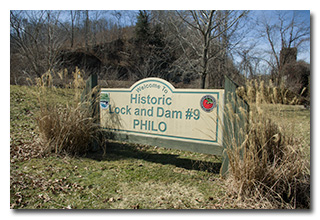 On Friday, March 4, 2022, one member of the Southeast Ohio Radio Adventure Team
performed a successful activation of Muskingum River State Park in Ohio as part of the Parks on the
Air (POTA; link) program.
On Friday, March 4, 2022, one member of the Southeast Ohio Radio Adventure Team
performed a successful activation of Muskingum River State Park in Ohio as part of the Parks on the
Air (POTA; link) program.
Having decided that his goal within POTA for the next few months would be to earn the Oasis Repeat Offender Activator Award for Muskingum River State Park by visiting all ten of the river-navigation locks and dams that make up the state park, Eric McFadden, WD8RIF, visited Philo Lock and Dam #9 on a cool but beautifully sunny day, arriving at the lock at about 1540 UTC. Eric was accompanied by his little dog Theo.
This was to be Eric's ninth activation of Muskingum River State Park, with his previous activations having occurred at...
- Devola Lock #2 (2022-02-18),
- Lowell Lock #3 (2022-02-25),
- Luke Chute Lock #5 (2022-02-19),
- Stockport Lock #6 (2018-09-15 / 2021-05-29),
- McConnelsville Lock #7 (2022-02-21),
- Rokeby Lock #8 (2021-02-27),
- Zanesville Lock #10 (2021-07-23).
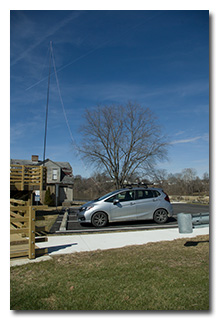 Finding a place for his car in the brand-new paved parking lot, Eric first walked little Theo while considering ways
to deploy his speaker-wire W3EDP Jr., an experimental half-size W3EDP end-fed Zepp antenna fashioned from a single length
of speaker-wire which he was hoping to test for the first time.
Finding a place for his car in the brand-new paved parking lot, Eric first walked little Theo while considering ways
to deploy his speaker-wire W3EDP Jr., an experimental half-size W3EDP end-fed Zepp antenna fashioned from a single length
of speaker-wire which he was hoping to test for the first time.
After noticing the sturdy handrail-posts on the elevated lock-overlook, Eric lashed his 31' Jackite telescoping mast to the posts using bungie cords and deployed his W3EDP Jr. as a slightly wonky inverted-vee. Because it wasn't quite warm enough for a comfortable outdoor operation, Eric set up his KX3 inside the car. Eric then verified that his KX3's internal automatic antenna tuner could easily find good matches for all nine HF bands, 10m through 80m, inclusive. Eric was on the air and ready to begin making QSOs at at 1603 UTC.
As he had hoped he would, Eric found he had good cell-signal at Philo Lock and Dam #9 and he was able to spot himself on POTA Spots (link) and to use POTA Spots to identify possible park-to-park (P2P) QSO opportunities.
Eric began his operation by consulting POTA Spots to identify possible P2P QSO opportunities. It was this point that he noticed two things: 1.) a 40m noise-floor of S6 and 2.) few POTA activators were operating on either 40m or 20m. Given the possibility—later confirmed—that the Earth was being struck by a coronal mass ejection (CME) from the Sun, Eric chose to not seek P2P QSOs at that time and concentrate on validating his activation before band conditions could degenerate further.
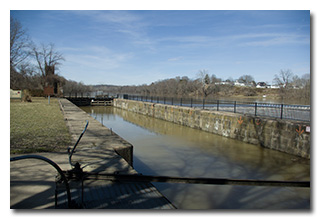 Finding himself disinclined to start his operation on 40m due to the high noise level on that band, Eric began his
operation by finding a frequency to run on 30m, spotting himself on POTA Spots, and calling "CQ POTA". Eric's first QSO
came at 1608 UTC with NP3K in Florida. QSOs came steadily on 30m, with Eric's thirteenth QSO coming at 1622 UTC with K9VIC
in Illinois. This run included QSOs with operators in Florida, New York (3), Wisconsin, Missouri, Illinois (2), Connecticut,
Tennessee, New Jersey, Maine, and Quebec.
Finding himself disinclined to start his operation on 40m due to the high noise level on that band, Eric began his
operation by finding a frequency to run on 30m, spotting himself on POTA Spots, and calling "CQ POTA". Eric's first QSO
came at 1608 UTC with NP3K in Florida. QSOs came steadily on 30m, with Eric's thirteenth QSO coming at 1622 UTC with K9VIC
in Illinois. This run included QSOs with operators in Florida, New York (3), Wisconsin, Missouri, Illinois (2), Connecticut,
Tennessee, New Jersey, Maine, and Quebec.
Switching to 20m, Eric found himself a frequency to run, began calling "CQ POTA", and was pleased to see that POTA Spots automatically updated his spot to reflect his 20m frequency. Eric's first QSO on 20m came at 1627 UTC with N4SAX in Florida. QSOs came slowly enough on 20m that Eric took several breaks to check POTA Spots for P2P QSO opportunities, but no P2P QSOs were made. Back on his 20m frequency, Eric's second 20m QSO came at 1639 UTC with VE1PVH in Nova Scotia.
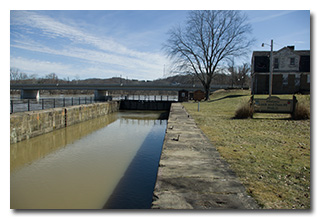 After fiddling with his KX3's noise blanker (NB) feature, Eric decided he could try to make some QSOs on 40m. Finding
a frequency to run, he began calling "CQ POTA" and was again pleased to see that POTA Spots automatically updated his
spot. Eric's first QSO on 40m came at 1643 UTC with K4DJG in Virginia. QSOs came quickly, with Eric's seventh QSO
in this run coming at 1648 UTC with W1EDX in Connecticut. This run included a P2P QSO with W4TRA who was activating
Mayo River State Park (K-2743) in North Carolina and QSOs with operators in Virginia (2), New York, Wisconsin,
North Carolina (2), New Hampshire, and Connecticut. Because of the high noise floor, Eric gave out many signal
reports of "559" and "539" but Eric was pleased to have been able to make QSOs on 40m despite the high noise level.
After fiddling with his KX3's noise blanker (NB) feature, Eric decided he could try to make some QSOs on 40m. Finding
a frequency to run, he began calling "CQ POTA" and was again pleased to see that POTA Spots automatically updated his
spot. Eric's first QSO on 40m came at 1643 UTC with K4DJG in Virginia. QSOs came quickly, with Eric's seventh QSO
in this run coming at 1648 UTC with W1EDX in Connecticut. This run included a P2P QSO with W4TRA who was activating
Mayo River State Park (K-2743) in North Carolina and QSOs with operators in Virginia (2), New York, Wisconsin,
North Carolina (2), New Hampshire, and Connecticut. Because of the high noise floor, Eric gave out many signal
reports of "559" and "539" but Eric was pleased to have been able to make QSOs on 40m despite the high noise level.
Eric finished his operation by checking POTA Spots for P2P QSO opportunities and 1657 UTC he made a P2P QSO on 20m with K5EDM who was activating Cove Creek State Natural Area (K-7162) in Arkansas. This was followed at 1701 UTC by a P2P QSO on 20m with K4NYM who was activating Horse Creek State Conservation Area (K-8719) in Florida
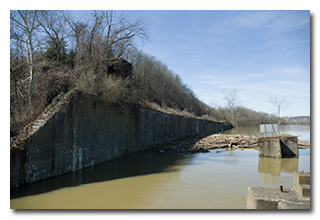 In all, Eric made twenty-five QSOs, including three P2P QSOs. All of Eric's QSOs were CW and were made with five watts
output.
In all, Eric made twenty-five QSOs, including three P2P QSOs. All of Eric's QSOs were CW and were made with five watts
output.
Signals strengths were lower than Eric would have expected, perhaps due to the ongoing CME-strike, but perhaps due to the speaker-wire W3EDP Jr. antenna. Eric was pleased enough with the performance of the speaker-wire W3EDP Jr. antenna to want to continue test it further at subsequent outings. The only significant problem Eric noticed with the antenna was a slight amount of RF on the metal bits of his CW paddle; there was just enough RF on the key to be noticable but not enough to be painful.
Eric also submitted his log to the World Wide Flora and Fauna in Amateur Radio (WWFF; link) program.
(return)